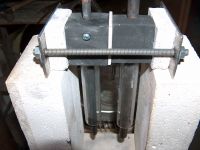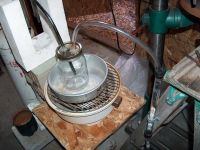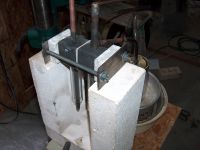
Mini Fused Salt Cell... Finally?
Chris, Fri Oct 19 2007, 09:53AMHere is my latest endeavor, with which I hope to electrolyze either eutetic NaCl/CaCl2 or LiCl. NaNO3 or LiNO3 (Darling Process) are another possibility. It looks almost halfways promising so far. I was almost able to finish the thing this weekend but I didn't quite have time and I didn't have a good way to vent out or otherwise dispose of the chlorine gas. Now it will probably be at least a few weeks before I can get home and work on it more.



The cell body is made from one of those 16oz propane canisters cut roughly in half. It is relatively thick steel. That will be suspended by bolts running through the firebrick on either side of the setup. I still need to braze a wire across the thing in the other direction to hang the stainless steel screen that will divide the cell in half. Both electrodes are held in a graphite block by a set screw, and surrounded by a tube made of fused quartz.
On the left is the graphite anode. A small hole in the top of the graphite block is to be connected to the chlorine vent tube. The fused quartz tube around the anode is held in by a set screw, which will no doubt need tightened as the cell warms up, and then loosened again before it can be allowed to cool down. There isn't anything more to the anode assembly really.
On the right is the cathode assembly, a little more complex. The cathode itself is a hollow stainless steel tube with a couple holes drilled in it above the cell liquid level so sodium can go inside it. The fused quartz tube around the cathode is sealed into the graphite block with boric oxide. It seemed to have no real problems with contraction when this assembly was cooled from something like 500C where I cast the boric oxide in down to room temperature. Nothing cracked, anyhow. The top of the tube and the graphite block will operate at a much lower temperature than the cell, and much lower than the melting point of boric oxide, because stainless steel is a poor thermal conductor and most of the outer tube will be filled with argon gas. Since the top of the assembly should be air tight, the sodium should not be able to rise higher than the hole where it enters the cathode itself. Obviously if the sodium did rise up into the top of the assembly it would reduce the boric oxide and screw everything up. The cathode has an outlet there above the graphite block, where it empties into a heated oil filled jar, which is in turn connected to a liquid filled tube with a valve at the bottom. That tube will be used to provide suction on the cathode tube until the piping is all primed with sodium, so it can run out into the collection jar under gravity. Obviously this will take some care since if any salt is sucked up into the tubing it will freeze and clog the thing. The cell will be rather well surrounded by refractory ceramic and firebrick to get it up to 600C. It is fired with propylene gas and the electrolysis runs on a large battery charger. Due to the rather small, distant, and otherwise inefficient electrode placing, I expect the full 12V of the battery charger will be dropped across the cell, and even then it will probably need additional heat from the torch. So far my major concerns are how well the thing will hold together under more temperature cycling, and how quickly liquid sodium might dissolve the brazed joints used here and there in the cathode assembly.



Re: Mini Fused Salt Cell... Finally?
..., Fri Oct 19 2007, 02:33PM
wow
I hope it works!
..., Fri Oct 19 2007, 02:33PM
wow

I hope it works!
Re: Mini Fused Salt Cell... Finally?
Eric, Fri Oct 19 2007, 10:31PM
Wow that's great, can't wait to hear if it works out.
You probably already know this but only a little escaped chlorine gas will rapidly corrode every steel object in the room. Especially tools like that drill press there. Been there done that...
Eric, Fri Oct 19 2007, 10:31PM
Wow that's great, can't wait to hear if it works out.
You probably already know this but only a little escaped chlorine gas will rapidly corrode every steel object in the room. Especially tools like that drill press there. Been there done that...
Re: Mini Fused Salt Cell... Finally?
Hazmatt_(The Underdog), Sat Oct 20 2007, 12:11AM
This is great. I hope you're still planning on reducing Potassium too.
Hazmatt_(The Underdog), Sat Oct 20 2007, 12:11AM
This is great. I hope you're still planning on reducing Potassium too.
Re: Mini Fused Salt Cell... Finally?
Chris, Sat Oct 20 2007, 12:16AM
Yes, I have found out the hard way already about corrosive gases acting upon tools. It has plagued me since I began chemistry.
Chris, Sat Oct 20 2007, 12:16AM
Yes, I have found out the hard way already about corrosive gases acting upon tools. It has plagued me since I began chemistry.
Re: Mini Fused Salt Cell... Finally?
thermite, Sun Feb 17 2008, 11:58PM
You will have terrible problems.
(1) chlorine is very corrosive.
(2) sodium ATOMS will dissolve into the salt and create short circuit current and loss by diffusing everywhere including to the anode.
Electrolysis of sodium chloride is a secret process of many companies - sorry to say that - and they dont share the information. If you are truly interested, you need a serious study of literature, write your findings in a monograph and submit for analysis for the second revision because the evil ones put a lot of lies of falsehoods in the publications.
thermite, Sun Feb 17 2008, 11:58PM
You will have terrible problems.
(1) chlorine is very corrosive.
(2) sodium ATOMS will dissolve into the salt and create short circuit current and loss by diffusing everywhere including to the anode.
Electrolysis of sodium chloride is a secret process of many companies - sorry to say that - and they dont share the information. If you are truly interested, you need a serious study of literature, write your findings in a monograph and submit for analysis for the second revision because the evil ones put a lot of lies of falsehoods in the publications.
Print this page